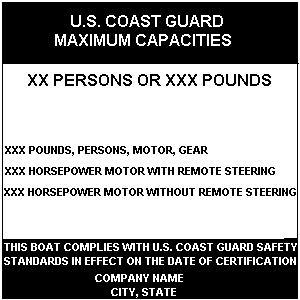Boat Capacities
Loading and Capacity Plates
The terms loading and capacity relate to the weight of people, fuel and gear that can be safely carried. The safe load of a boat in terms of people depends on a number of characteristics, including hull volume and dimension, the weight of the engine and, if an outboard, how is it mounted. The number of seats in a boat is not an indication of the number of people it can safely carry. Capacity plates can generally be found on the inside transom, or next to the helm station.
Capacity plates should never be removed, altered, or tampered with. While it is not a Federal violation for a boat owner to exceed the listed capacities, many states do have statutes prohibiting the carriage of people and gear in excess of the stated capacity, or the installation of a motor that exceeds the recommended horse power limit. Also, you may void your insurance policy if you are found to have exceeded the limits stated on your capacity plate.
Under the U.S. Coast Guard Federal Boat Safety Act of 1971, boats less than 20 feet powered with an inboard, outboard, or stern drive engine manufactured after November 1, 1972, must display a capacity plate defining the safe load limits. This plate must be mounted where you can see it when preparing to get underway. Sailboats, canoes, kayaks and inflatable boats are exempt from this standard states do have statutes prohibiting the carriage of people and gear in excess of the stated capacity, or the installation of a motor that exceeds the recommended horse power limit. Also, you may void your insurance policy if you are found to have exceeded the limits stated on your capacity plate.
Typical Capacity Plate Information by Boat Type
- Boats powered by outboards: The maximum persons capacity in pounds and maximum weight capacity (persons, motor and gear) in pounds and maximum horsepower capacity.
- Boats powered by inboards and stern drives: the maximum persons capacity in pounds and maximum weight capacity (persons and gear). The Coast Guard Safe Powering Standard does not apply to inboards, stern drives, etc.
- Manually propelled boats: The maximum persons capacity in pounds and maximum weight capacity (persons and gear).

Also keep in mind the limits defined on capacity plates apply in good to moderate weather conditions. In rough waters, keep the weight well below the limit. In ideal weather conditions, it is recommended that you distribute your load evenly, keep weight low, and avoid abrupt changes in distribution. This is especially important if your boat’s capacity is fully used or if weather conditions deteriorate. It is also important to remember that people represent a "live" load and moving about affects a boat quite differently than static loads. In general, shift human or other weight only after stopping or slowing.

